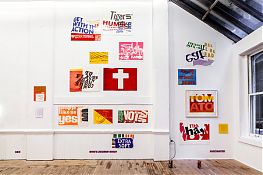The New York Times
December 19, 2013
Art as Currency in a Tragic Time
By HOLLAND COTTER
A personal art collection can be displayed as a trophy room or as a diary. The Ileana Sonnabend exhibition at the Museum of Modern Art is cast in greatest-hits mode; MoMA’s the right place for it. “Macho Man, Tell It to My Heart: Collected by Julie Ault” at the nonprofit gallery Artists Space is an intimate document, scrappy, annotated, apartment size. The whole thing, 200 pieces stretched over two locations, could probably fit in a decent-size studio, if you stored some behind furniture and under the bed.
Julie Ault, an artist, writer and curator, was a founding member of the New York collaborative Group Material, which, from the late 1970s to the late ’90s, used exhibitions and public events to explore the overlap of art and politics. During decades of depression and inflation, multiculturalism, conservatism and AIDS, she and her colleagues lived improvised lives on the city’s fringes.
Within their community, art was the currency for gift giving, bartering and sometimes selling, among friends.
Ms. Ault’s collection reads as a map of such exchanges. And its dynamics are embodied in a handful of small pieces clustered on a wall just off the elevator at Artists Space’s Greene Street headquarters. By reading the unusually detailed credit lines, we learn that a 1906 Edward S. Curtis photograph was purchased by Ms. Ault from a gallery in 1987, and that it is still in her possession. A painting by the preacher-artist Howard Finster, acquired the same year, however, she later gave to a fellow writer and curator, Brian Wallis, who has lent it to the show.
The artist Nancy Spero made a gift of a print to Ms. Ault in 1988. In 2004, Ms. Ault passed that print on to another artist, Roni Horn, who has, over years, donated several examples of her own work to Ms. Ault. So it goes, in a collection that seems to exist in state of continual addition, subtraction and circulation.
Within this flux, certain artists recur. Ms. Horn is one. The photographer Andres Serrano, once married to Ms. Ault, is another. Photographs and drawings by Felix Gonzalez-Torres, a member of Group Material, recur, luminous, tender, muted, throughout, as do paintings by the great Martin Wong. Both artists died of AIDS in the late 1990s, and their presence here is a reminder that, beyond being a gauge of individual taste, a collection is a reflection of its time and place in history.
Ms. Ault’s relationship to that history has always been actively political, which in part explains her enthusiasm for the art of Corita Kent — Sister Corita — whose exuberant silk-screen posters from the 1960s, with their calls for peace, tolerance, and liberationist spirituality, fill the walls of Artists Space’s auxiliary gallery at 55 Walker Street.
There, they interact with work by younger artists: an intensely homosocial, if not exactly homoerotic film by the young Danish artist Rasmus Rohling; wall pieces by Steven Evans that spell the titles of AIDS-era disco songs like the ones that gives the exhibition its name; and a series of funky objects — bricks painted to look like burning buildings — by Tim Rollins + K.O.S. (Kids of Survival), a teacher-and-students collective working in the bombed-out South Bronx in the early 1980s.
The Artists Space show is itself a collective effort, with a team of curators that includes, along with Ms. Ault, Martin Beck, Richard Birkett, Nikola Dietrich, Stefan Kalmar, Heinz Peter Knes, Jason Simon, Scott Cameron Weaver, and Danh Vo. Several of them contribute to the anecdotal catalog, produced for earlier versions of the show in Europe.
In addition, Mr. Simon has assembled a program of films for the occasion, including two beauties by Baylis Glascock about Sister Corita. And Mr. Vo, an international star and an assiduous acquirer of work by Mr. Wong and other gay artists, has expanded the exhibition — and neatly finessed the idea of a collection being the product of a single sensibility — by inserting material from his own holdings.
The result is a portrait, in objects, not just of one person but of many; the diary of an era that valued community as retold in a time that doesn’t. It’s a view of a collection not as a monument carved in stone, but as energy gathering and dispersing, as a page still being written on.
“Macho Man, Tell It to My Heart: Collected by Julie Ault” continues through Feb.23 at two Artists Space locations: 38 Greene Street and 55 Walker Street, SoHo; 212-226-3970, artistsspace.org.
More in Art & Design (5 of 52 articles)
ArtsBeat: Study Documents 2012 Downturn in Chinese Art Market
Read More »
